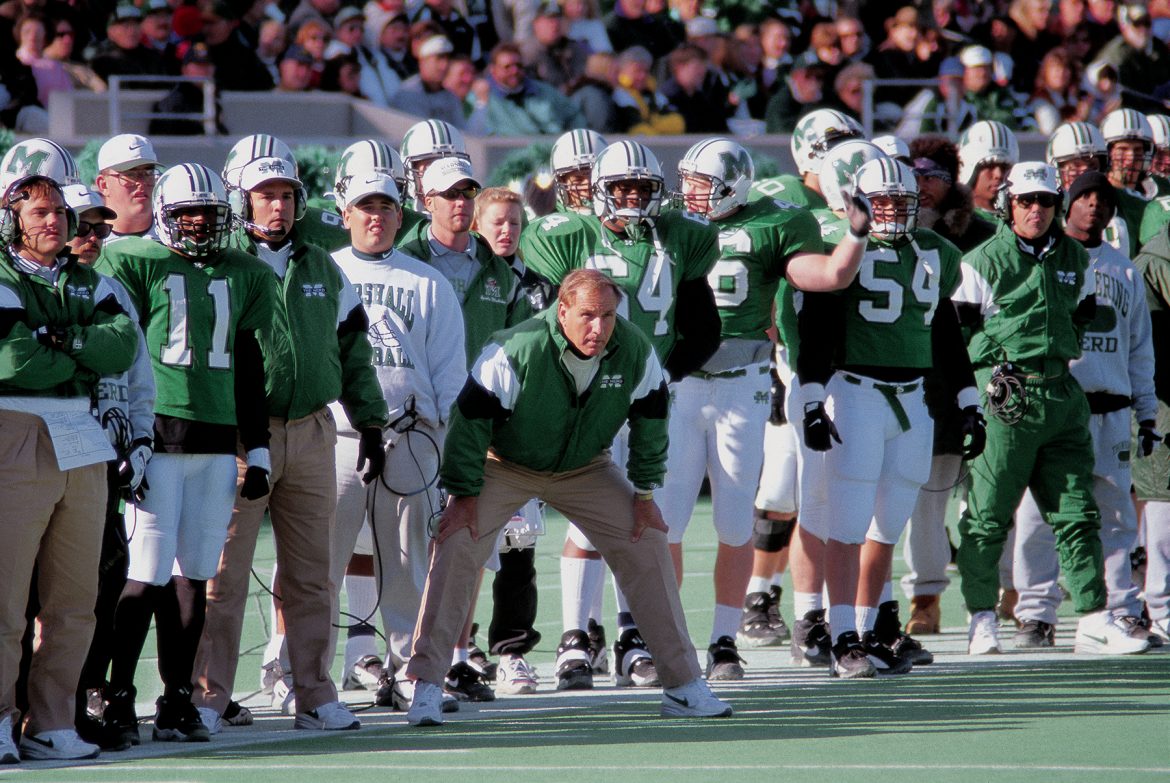A football program that has seen scandal, tragedy and rebirth makes its triumphant return to the MAC & Division 1 competition
By Dave Wellman
HQ 29 | AUTUMN 1997
“Remember the MAC.” Marshall football fans might as well say “Remember the Alamo” as they prepare for their beloved Thundering Herd to rejoin the Mid-American Conference and Division I-A competition this fall.
To many, it seems almost inconceivable that Marshall would return to the conference that kicked it out nearly 28 years ago. But to others who don’t know about the reasons for that disastrous time in Thundering Herd sports history, this is the right move. Bygones are bygones, they say. Forgive and forget. So, two years after accepting the MAC’s invitation to rejoin, Marshall is back. Back in the MAC.
Who would have thought it possible? Thinking back to 1969, probably no one. On and off the field it was a depressing time in Marshall football history, those late 1960s. At one point, the team registered a 27-game non-winning streak. The 1968 Thundering Herd, in its last season as a Mid-American Conference member, posted a 0-9-1 record and was outscored by its opponents 358-129. It all culminated when the university was suspended indefinitely from the MAC, its punishment for allegedly committing more than 140 recruiting violations. It wasn’t uncommon for a recruit or a Marshall player back then to find money in an envelope under his plate after eating a meal, says former Marshall player Nate Ruffin.

“If you needed certain things, they’d look out for you,” Ruffin says in Rolling Thunder, a book that chronicled Marshall football from 1967 through 1987. Here Marshall was, 28 years ago this summer, a school without a conference, a school with horrible athletic facilities and a school without a football coach. Then, 15 months later, after the worst tragedy of all, it was a school without a football team. In the worst sports tragedy ever, most of Marshall’s players and coaches were killed on November 14, 1970, as a Southern Airways DC-9 carrying the team back from a game at East Carolina crashed near Tri-State Airport. The shame of a recruiting scandal and banishment from its league was minor compared to the tragedy of 1970 which, today, is simply known as the crash.
Marshall football, many thought, died along with the players, coaches and supporters who were aboard that plane that crashed into a Kenova hillside just short of Tri-State Airport. In all, 75 people, including 37 players, eight coaches and administrative personnel, 25 fans and the jetliner’s crew of five, died.
Perhaps MU never would field another team, some thought after the shock wore off. And some even pushed for the school to drop football for good. But nobody, at least those whose opinions mattered, listened. Thankfully.
Through all the heartbreak, the only game Marshall failed to show for was its scheduled season-finale with Ohio University on November 21, 1970, a week after the crash. The next season, the Young Thundering Herd, as the team was affectionately known, played 10 games, miraculously winning two under new Coach Jack Lengyel. Two victories, just months after the crash? Who would have believed it. The football program lived!
But then, the optimism was replaced by the usual frustration as Marshall managed just eight total victories in the next five seasons under coaches Frank Ellwood and Sonny Randle. And the Herd struggled in the Southern Conference, failing to win a league game until 1981 in its fifth year in the SC.
When would it all change? In 1984, many say, looking back. No, it was the Randle years, others say.
Stan Parrish took over as coach of the Herd in 1984 and guided Marshall to a 6-5 record, its first winning season in 20 years. The nation’s longest active streak of non-winning and losing seasons was over, and Herd fans celebrated as if they’d just won the national championship.
Suddenly, it appeared, with that one winning season, the Thundering Herd had turned things around.
It had. It really had. Want proof?
Not only did Marshall record nothing but winning seasons after the turnaround year of 1984, it progressed into perhaps the top I-AA program in the country, under coaches George Chaump, Jim Donnan and, of course, Bobby Pruett.

Consider: Three years after the first winning season in ’84, Marshall played for the NCAA Division I-AA- national championship in 1987. Five years later in 1992, it won the I-AA championship. Four years later in 1996, it won the I-AA championship again. All the Herd did was score 658 points and post a perfect 15-0 record.
And four times during that 10-year period from 1987 to 1996, Marshall finished second in the nation. My, what might have been.
Without question, Marshall’s football program outgrew the Southern Conference and I-AA competition.
Now, the Herd returns home to the MAC, where it belongs. Or does it? Some say yes, others say no, still others aren’t sure yet.
Pruett, a Marshall grad and former Herd player, says “yes.”
“Our expectations and goals are high,” Pruett says. “It’s the conference I played in. Plus, it’s a chance to play Division I football.”
It’s also a chance to show the MAC a thing or two, like a fancy, new, 30,000 seat stadium, and a group of talented football players. The most notable, of course, is sophomore Randy Moss, who is being touted by the school and sports publications as a Heisman Trophy candidate.
Moss is a lean 6′ 5″, 210-pounder from Rand, W.Va., where he was all-everything at DuPont High School. He has big-time speed as he proved in the Southern Conference Indoor Track and Field Championships last February, winning the 200-meters in 21.15 which qualified him for the NCAA Championships. To get ready, he practiced just three times.
He has big-time receiving ability as he proved in his first year at Marshall, catching 78 passes for 1,709 yards and an incredible 28 touchdowns. Moss also led the nation in kickoff returns with an average of 34.5 yards per return. The result of that combination of speed, height and the ability to catch a football make Moss, in Pruett’s words, ‘a superstar.’
But Pruett knows best that having a superstar on your team does not guarantee victories.
“Randy’s a great player, but football is a team sport,” Pruett says.
Moss, in fact, says little about all the Heisman hype and the individual honors. All he wants, he says, is to win. “It’s all about teamwork,” Moss says. “A win is not only based on talent, but who works together, who works the hardest. That’s who will win the MAC.”
Undoubtedly, Marshall will be proud to show MAC opponents its stadium, which opened in 1991 and has been home to the I-AA championship game annually since 1992. Beginning this year and running at least through 1999, the MAC title game will be played at MU.
“The ability of the Huntington Sports Committee to secure the MAC championship game for the first time is obviously a big plus for the Tri-State, and an opportunity for us to showcase the stadium,” says Marshall Athletic Director Lance West.
MAC Commissioner Jerry Ippoliti says the league is proud to stage its championship contest in Huntington.
“The facility is certainly one that’s going to bring great identity to the MAC,” Ippoliti says. “It portrays class and success.”
The new stadium, many feel, is a major reason why the MAC wanted Marshall back in its league after bidding MU good riddance 28 years ago. Ippoliti doesn’t deny that, but says the stadium was only one factor in the league’s decision to readmit MU to the conference.

“We were just very impressed how they developed into a Division I-A program,” Ippoliti says. “Even though they were classified I-AA, they were operating at the I-A level.”
When Marshall was kicked out of the MAC, the league called the move an indefinite suspension, one that could be lifted if the school righted its sinful wrongs. It took a while, but ‘obviously’ Marshall has been forgiven of its sins.
West says Marshall’s recent football success and the MAC’s desire to grow made for the perfect match.
Marshall is not the only school joining the MAC this year. Northern Illinois University of DeKalb, Ill., which is located just west of Chicago, also has entered the league. And next year, Buffalo (N.Y.) University comes aboard, giving the MAC 13 members.
For now, though, the emphasis is on September 13, 1997 when MU visits Kent, Ohio, to play the Flashes in its first league game.
Predicting how Marshall will fare in I-A is easy for some, tough for others. Moss expects the Herd to continue its success, despite the move up.
“I don’t think the MAC will be that hard,” he says. “It’s just about who wants it the most. We have something to prove – that Marshall’s not just a I-AA powerhouse.”
The Herd returns 40 lettermen, including nine starters from last year. But it also lost a load of talent from a team that had 19 all-conference selections and 11 All-Americans. Seven former Herd players took part in NFL camps this summer.
Pruett calls the upcoming season ‘a major undertaking’ for his squad. “We have to earn our respect,” he says.
Apparently, many members of the media already have a lot of respect for Marshall’s program. In its pre-season poll released in late July, the media picked the Herd second behind Miami in the Eastern Division.
Moss is not the only star on this team. Among the others are center John Wade, who already has been invited to play in the Blue-Gray Bowl game and the Senior Bowl, and linebacker Larry McCloud, an all-American last year and the team’s leading tackler each of the past two seasons.
Aggressive All-American B.J. Cohen is back at defensive end, and talented sophomore Doug Chapman returns to the Thundering Herd backfield. Chapman became the first MU freshman in 17 years to rush for more than 1,000 yards last season when he finished with 1,238 yards. For good measure, he scored 16 touchdowns.
Most Herd fans will be watching closely the man who is expected to throw all those passes to Moss. Chad Pennington, a sophomore, was redshirted in 1996 after Eric Kresser transferred to Marshall from the University of Florida for his senior year. Kresser passed for 3,407 yards and 31 touchdowns, led Marshall to the national championship, and then signed with the Cincinnati Bengals.

Pennington, meanwhile, studied Kresser from the sidelines and added some arm strength. It’s not as if he was weak when he directed Marshall to the I-AA title game as a true freshman in 1995. That year, the cool Pennington passed for 2,445 yards and 15 touchdowns after the first two quarterbacks, Larry Harris and Mark Zban, suffered injuries.
Although the Herd plays just five home games this season, and it’s heading north, rather than south, to play league foes Kent, Ball State, Miami and Central Michigan, Pruett expects Marshall’s fans to not miss a beat.
“I think our fans are excited,” he says. “They’ve always supported Marshall very, very well and I think they’ll continue to support us.”
Ohio University Coach Jim Grobe says he anticipates ‘a big-time rivalry’ between his Bobcats and the Herd.
“It’s great for the MAC and it’s great for Marshall,” Grobe says. “They had reached the pinnacle in I-AA football. I’m not sure how much more they could do, except for setting a goal of winning the most I-AA championships.”
An added plus for Marshall joining the MAC and moving up to Division I-A is its first chance to play West Virginia University in 74 years. The teams played August 30 in Morgantown.
The MAC champion will play in the Ford Motor City Bowl at the Silver Dome in Detroit December 26, with participants getting $750,000. That, combined with the $300,000 Marshall earned for playing at WVU in the opener, would give the school more than $1 million if it happens to make it to the Silver Dome.
No wonder Pruett and Marshall fans are so excited.





